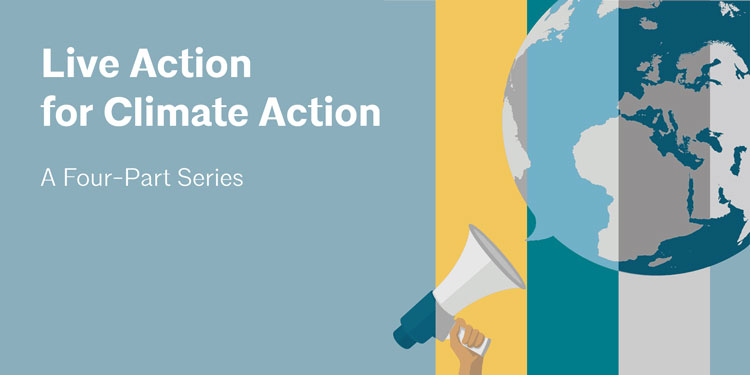
Date: | Time: May - June 2021 - 1.25 AIA Health, Safety, Welfare (HSW) Credit per Webinar
Live Action for Climate Action Four-Part HSW Series
Live Action for Climate Action is a four-part series that will dive into the 2030 Challenge adopted by the AIA, the materials and tools necessary for creating a sustainable world, resiliency and adaptability moving forward, and designing for health and well-being. Each event is the first course in each of AIAU’s four main climate action series.
Each course is worth 1.25 Health, Safety, Welfare (HSW) Learning Units & all courses begin at noon on their respective dates.
You can RSVP to each course here, and see each course’s description below.
MAY 27 – The 2030 Challenge: Goals and Design Processes
JUNE 3 – Materials Matter: The Big Idea
JUNE 10 – Resilience + Adaptation: An Introduction
JUNE 24 – Designing for Health and Well-Being
The 2030 Challenge: Goals and Design Processes
The first installment in the AIA+2030 Online Series AIAU Certificate Program, this course would traditionally cost $25 for AIA Members and $40 for non-members.
This program is sponsored by Kingspan.
DESCRIPTION:
The building sector is the single largest consumer of energy and producer of greenhouse gas emissions. The 2030 Challenge, adopted by the AIA, provides a path to reducing our sector’s negative impacts and reaching carbon neutral design as the standard practice. This series will inspire architects to meet the 2030 Challenge through design strategies, efficient technologies and systems, and applying renewable energy resources.
The design process is an important element in the creation of next-generation buildings that meet the 2030 Challenge targets. In the first course of the AIA+2030 Online Series, we will explore the design processes to produce high-performance and carbon neutral buildings, including the Integrative Design Process (IDP). We will explore collaborative strategies that can achieve low energy outcomes, and how these strategies can be used as a roadmap throughout the design process. In particular, we will examine defining core, early design decisions such as building form and orientation.
LEARNING OBJECTIVES:
• Explain the 2030 Challenge, its baselines and metrics, and what design processes are needed to achieve 2030 • Challenge targets.
• Explain how an energy efficient design process differs from traditional design.
• Identify specific characteristics of an energy efficient and integrative design process.
• Explain the importance of energy analysis and assessment throughout the design process.
Materials Matter: The Big Idea
The first installment in the Materials Matter AIAU Certificate Program, this course would traditionally cost $25 for AIA Members and $40 for non-members.
DESCRIPTION:
You wouldn’t buy a car without checking its gas mileage, so why wouldn’t you want to know what goes into your building? In this course, you’ll learn about the potential health and environmental impacts of the products that go into our buildings. You’ll also look at key drivers pushing transparency in the marketplace including client demand and green rating systems.
LEARNING OBJECTIVES:
• Understand potential impacts of materials on human health and the environment.
• Identify two tools available to architects to translate health and environmental information for practical implementation.
• Understand some policy and market drivers influencing materials improvements.
• Identify three actions you could undertake today to improve material performance.
Resilience + Adaptation: An Introduction
The first installment in the AIA Resilience and Adaptation AIAU Certificate Program, this course would traditionally cost $25 for AIA Members and $40 for non-members.
DESCRIPTION:
Get started on the path to integrating resilient design services into your firm and engaging, in a meaningful way, in resilience conversations and efforts.
This detailed and interactive course introduces resilience and adaptation foundations, including history and evolution, and offers key data points that will help you develop as a knowledgeable resource on the topic, support your efforts to integrate resilient design services into your firm, and be equipped to participate in local and national resilience conversations and efforts.
LEARNING OBJECTIVES:
• Describe shocks and stresses most critical to the built environment and the important role of architects in protecting people and property.
• Explain the performance attributes of hazard mitigation, resilience, and adaptation as different approaches to address shocks and stresses in the built environment.
• Discuss the qualities and characteristics of resilient and adaptable design strategies.
• Describe different roles and responsibilities for architects forwarding resilience goals.
Designing for Health and Well-Being
The first installment in the Designing for Health AIAU Series, this course would traditionally cost $25 for AIA Members and $40 for non-members.
DESCRIPTION:
Licensed architects and affiliated design professionals have, in their professional practice, a positive duty to protect the public’s health, safety, and welfare. As America’s healthcare expenses continue to rise and we rebuild post-pandemic, collaboration with public health professionals will be more critical than ever.
In this course, you will hear from architects and public health professionals about opportunities to influence population health directly and indirectly through design. We will explore the basics of public health as it relates to architecture and describe six approaches any designer can apply to any project to think more intentionally about health promotion.
LEARNING OBJECTIVES:
• Define public health and its connection to architecture.
• Articulate the relationship of the physical environment to social, behavioral, mental, and emotional health.
• Describe the role architects and the built environment have in reducing health care costs and promoting health.
• Apply six approaches for thinking about public health in building design.
